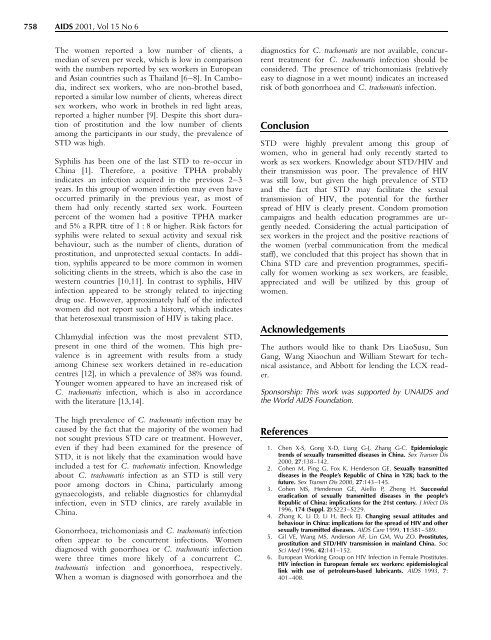High prevalence of syphilis and other sexually transmitted diseases ...
High prevalence of syphilis and other sexually transmitted diseases ...
High prevalence of syphilis and other sexually transmitted diseases ...
Create successful ePaper yourself
Turn your PDF publications into a flip-book with our unique Google optimized e-Paper software.
758AIDS 2001, Vol 15 No 6The women reported a low number <strong>of</strong> clients, amedian <strong>of</strong> seven per week, which is low in comparisonwith the numbers reported by sex workers in European<strong>and</strong> Asian countries such as Thail<strong>and</strong> [6±8]. In Cambodia,indirect sex workers, who are non-brothel based,reported a similar low number <strong>of</strong> clients, whereas directsex workers, who work in brothels in red light areas,reported a higher number [9]. Despite this short duration<strong>of</strong> prostitution <strong>and</strong> the low number <strong>of</strong> clientsamong the participants in our study, the <strong>prevalence</strong> <strong>of</strong>STD was high.Syphilis has been one <strong>of</strong> the last STD to re-occur inChina [1]. Therefore, a positive TPHA probablyindicates an infection acquired in the previous 2±3years. In this group <strong>of</strong> women infection may even haveoccurred primarily in the previous year, as most <strong>of</strong>them had only recently started sex work. Fourteenpercent <strong>of</strong> the women had a positive TPHA marker<strong>and</strong> 5% a RPR titre <strong>of</strong> 1 : 8 or higher. Risk factors for<strong>syphilis</strong> were related to sexual activity <strong>and</strong> sexual riskbehaviour, such as the number <strong>of</strong> clients, duration <strong>of</strong>prostitution, <strong>and</strong> unprotected sexual contacts. In addition,<strong>syphilis</strong> appeared to be more common in womensoliciting clients in the streets, which is also the case inwestern countries [10,11]. In contrast to <strong>syphilis</strong>, HIVinfection appeared to be strongly related to injectingdrug use. However, approximately half <strong>of</strong> the infectedwomen did not report such a history, which indicatesthat heterosexual transmission <strong>of</strong> HIV is taking place.Chlamydial infection was the most prevalent STD,present in one third <strong>of</strong> the women. This high <strong>prevalence</strong>is in agreement with results from a studyamong Chinese sex workers detained in re-educationcentres [12], in which a <strong>prevalence</strong> <strong>of</strong> 38% was found.Younger women appeared to have an increased risk <strong>of</strong>C. trachomatis infection, which is also in accordancewith the literature [13,14].The high <strong>prevalence</strong> <strong>of</strong> C. trachomatis infection may becaused by the fact that the majority <strong>of</strong> the women hadnot sought previous STD care or treatment. However,even if they had been examined for the presence <strong>of</strong>STD, it is not likely that the examination would haveincluded a test for C. trachomatis infection. Knowledgeabout C. trachomatis infection as an STD is still verypoor among doctors in China, particularly amonggynaecologists, <strong>and</strong> reliable diagnostics for chlamydialinfection, even in STD clinics, are rarely available inChina.Gonorrhoea, trichomoniasis <strong>and</strong> C. trachomatis infection<strong>of</strong>ten appear to be concurrent infections. Womendiagnosed with gonorrhoea or C. trachomatis infectionwere three times more likely <strong>of</strong> a concurrent C.trachomatis infection <strong>and</strong> gonorrhoea, respectively.When a woman is diagnosed with gonorrhoea <strong>and</strong> thediagnostics for C. trachomatis are not available, concurrenttreatment for C. trachomatis infection should beconsidered. The presence <strong>of</strong> trichomoniasis (relativelyeasy to diagnose in a wet mount) indicates an increasedrisk <strong>of</strong> both gonorrhoea <strong>and</strong> C. trachomatis infection.ConclusionSTD were highly prevalent among this group <strong>of</strong>women, who in general had only recently started towork as sex workers. Knowledge about STD/HIV <strong>and</strong>their transmission was poor. The <strong>prevalence</strong> <strong>of</strong> HIVwas still low, but given the high <strong>prevalence</strong> <strong>of</strong> STD<strong>and</strong> the fact that STD may facilitate the sexualtransmission <strong>of</strong> HIV, the potential for the furtherspread <strong>of</strong> HIV is clearly present. Condom promotioncampaigns <strong>and</strong> health education programmes are urgentlyneeded. Considering the actual participation <strong>of</strong>sex workers in the project <strong>and</strong> the positive reactions <strong>of</strong>the women (verbal communication from the medicalstaff), we concluded that this project has shown that inChina STD care <strong>and</strong> prevention programmes, speci®callyfor women working as sex workers, are feasible,appreciated <strong>and</strong> will be utilized by this group <strong>of</strong>women.AcknowledgementsThe authors would like to thank Drs LiaoSusu, SunGang, Wang Xiaochun <strong>and</strong> William Stewart for technicalassistance, <strong>and</strong> Abbott for lending the LCX reader.Sponsorship: This work was supported by UNAIDS <strong>and</strong>the World AIDS Foundation.References1. Chen X-S, Gong X-D, Liang G-J, Zhang G-C. Epidemiologictrends <strong>of</strong> <strong>sexually</strong> <strong>transmitted</strong> <strong>diseases</strong> in China. Sex Transm Dis2000, 27:138±142.2. Cohen M, Ping G, Fox K, Henderson GE. Sexually <strong>transmitted</strong><strong>diseases</strong> in the People's Republic <strong>of</strong> China in Y2K; back to thefuture. Sex Transm Dis 2000, 27:143±145.3. Cohen MS, Henderson GE, Aiello P, Zheng H. Successfuleradication <strong>of</strong> <strong>sexually</strong> <strong>transmitted</strong> <strong>diseases</strong> in the people'sRepublic <strong>of</strong> China: implications for the 21st century. J Infect Dis1996, 174 (Suppl. 2):S223±S229.4. Zhang K, Li D, Li H, Beck EJ. Changing sexual attitudes <strong>and</strong>behaviour in China: implications for the spread <strong>of</strong> HIV <strong>and</strong> <strong>other</strong><strong>sexually</strong> <strong>transmitted</strong> <strong>diseases</strong>. AIDS Care 1999, 11:581±589.5. Gil VE, Wang MS, Anderson AF, Lin GM, Wu ZO. Prostitutes,prostitution <strong>and</strong> STD/HIV transmission in mainl<strong>and</strong> China. SocSci Med 1996, 42:141±152.6. European Working Group on HIV Infection in Female Prostitutes.HIV infection in European female sex workers: epidemiologicallink with use <strong>of</strong> petroleum-based lubricants. AIDS 1993, 7:401±408.















